18th October 2012
The penultimate blog from my recent trip to Australia, courtesy of the South Australian and Tasmanian tourist boards.
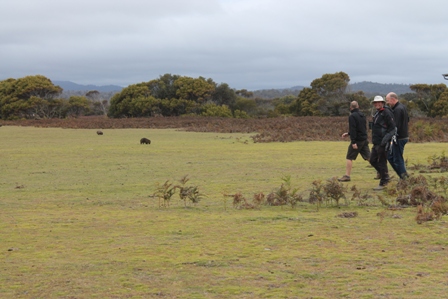
Our driver Simon Stubbs, Rob and Mike (plus Common Wombats, left) at Narawntapu NP, Tasmania, 18/10/12 (Dominic Couzens)
“Please miss, could we see a Platypus?” We didn’t exactly say that, but it wasn’t far off. Up to now on this astonishing trip we had seen pretty much everything we could possibly have wanted, from Echidnas to Devils and from Emus to Emu-wrens. However, as far as Australian icons go, the Platypus is hard to beat and at least three members of the party, Rob, Mike and Ray, were itching to see one before they went home (Tim and I had both encountered this wondrous animal before). Hence the plaintive requests to Tonia, who, having secured all Tasmanian endemic birds and plenty more besides, now set Plan Platypus into action.
Platypuses are mainly crepuscular, meaning they are most active at dawn and dusk, and this effectively scuppered our first attempt to see these aquatic mammals, at Fernglade Reserve, near Burnie on the northern coast of Tasmania, where we had lunch. The habitat looked perfect, but all we could find here was birds, wretched things. We found enough Pink Robins for a flower arrangement, and enough Scrubtits to scrub their “tricky to find” status. It was as if Tasmania was telling us: “I thought you guys were birders?”
Well we were birders, and the schedule moved us on towards a promised nest of Grey Goshawks. In order to get the precise location, we called in on a lady who must have owned the finest garden in Tassie. For a start it was dripping with birds (including Yellow-throated Honeyeaters) and secondly, it overlooked the ocean from the top of a cliff. While we were watching the inevitable fly-bys and rafts of Short-tailed Shearwaters (being birders, as we were and are), something unexpected happened – half a mile offshore there was a mighty splash, visible to the naked eye. The yell of “WHALE!” went up, and after what amounted to a somewhat tense wait (in a complete stranger’s garden, with the schedule going up in flames), everybody managed to get a glimpse of it: a Humpback, breaching at agonisingly long intervals. Was the day switching towards mammals?
The town of Latrobe calls itself the Platypus Capital of the World. If you miss that less than subtle clue, there is a great big plastic model of a Platypus outside the Visitor Centre, just to ensure that the possibility is spelled out clearly. Tonia got out of the minibus and said: “There’s one!” And we laughed.
But she meant it. She had seen a real, wild Platypus, which prompty disappeared downriver. Cue another gut-wrenching wait; fingernails were pretty much falling
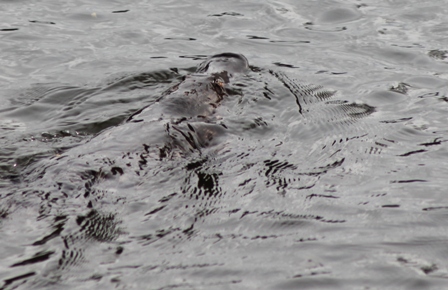
Platypus, Latrobe, Tasmania, 18/10/12 (Dominic Couzens)
to the ground like snow before the animal appeared. Anyhow eventually, having made the Poms suffer a little, the Platypus swam unconcernedly up and down the Mersey River, giving us the best views that it possibly could, with its flat tail, webbed feet, upwardly-placed eyes and duck-like bill all duly noted and admired. It came to within just a few feet of us at times,
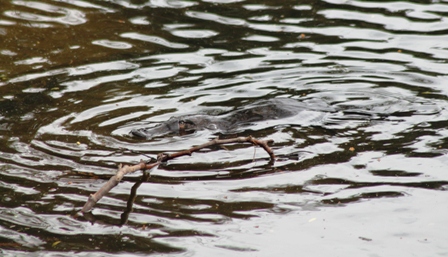
Platypus (and stick), Latrobe, Tasmania, 18/10/12 (Dominic Couzens)
evidently quite used to the many people who walk up and down the riverside walk here. It’s easy to forget what extraordinary animals these are: egg-laying, with ankle spurs that hold venom (in the male), a body temperature lower than other mammals, the sensory bill and the ability to detect electric fields. The venom of a platypus can kill a small dog and is very painful even to humans. Thus this animal is a survivor as well as being very, very odd.
“We’ve got to get to Poo Park,” announced Tonia at length, after we had paid homage for well over an hour. The park to which she was referring is actually called Narawntapu National Park, recently changed from Asbestos Ranges NP for reasons of attracting tourists who don’t wish to be poisoned. I was looking forward to this section of the trip because Poo Park is sometimes described as “The Serengeti of Tasmania”, owing to the large numbers of large grazing mammals that can be seen there, even in the middle of the day. And sure enough, although it isn’t the Serengeti, we had no trouble seeing a lot of
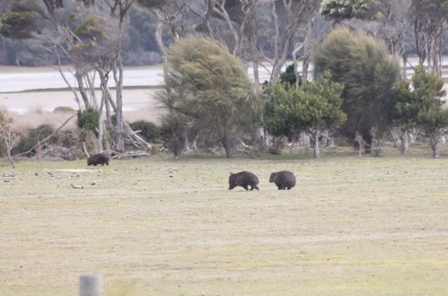
Common Wombats, Narawntapu NP, Tasmania, 18/10/12 (Dominic Couzens)
stuff. The most unusual sight here is the astonishing number of Common Wombats that graze the open spaces and virtually wander around at your feet. Normally these animals are nocturnal, but not here, and it isn’t difficult to see up to ten or more in a single scan: in most of Australia you would be fortunate to see one as you drove along rural
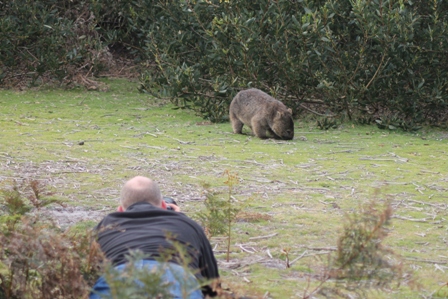
Mike Unwin photographing Common Wombat, Narawntapu NP, Tasmania, 18/10/12 (Dominic Couzens)
roads at night, and that would be scuttling away in its bottom-heavy way. Not surprisingly, with so many Wombats about, they left plenty of field signs – their large burrows (single, not in warrens as in the Hairy-nosed Wombats, see earlier posts) and their droppings which, famously, happen to be cube-shaped. The point of this shape is that Common Wombats are territorial and mark their ground, as do many animals, by
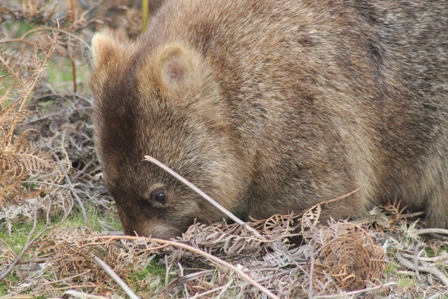
Common Wombat, Narawntapu NP, Tasmania, 18/10/12 (Dominic Couzens)
defaecating in prominent places. Cuboidal scats, unlike spherical scats, don’t roll out of position – or so the theory goes. So now you know about the poo of Pu Park.
Besides the Wombats, this area was full of other animals, including the Tasmanian race of the Eastern Grey Kangaroo (locally called the Forester), Bennett’s Wallabies and plenty of Tasmanian Pademelons.
By now, as you can gather, we were seriously on a mammal roll, and things only got better after supper, when we went spotlighting near our ornate hotel at Hawley Beach. Visiting the nearby Little Penguin colony in the company of Nick Mooney, possibly Tasmania’s best known wildlife expert and one of the world authorites on the Tasmanian Devil, we came across dozens more Pademelons, and also had a quick glimpse of a Southern Brown Bandicoot. Later on Nick kindly took Mike, Rob and I spotlighting into the nearby town of Port Sorell, where he had suggested that, if we were very fortunate, we might find the highly localised Eastern Barred Bandicoot. In contrast to the much commoner Southern Browns, these animals, now almost extinct on the mainland of Australia, can be found on well cropped lawns and roadsides. As it happened, we did come across one (record shot below), as well as lots of Rabbits, Brush-tailed Possum, a Long-nosed Potoroo, a close Southern Brown Bandicoot and a mother and baby Ring-tailed Possum. That made it, remarkably, 12 species on mammal on this single day.
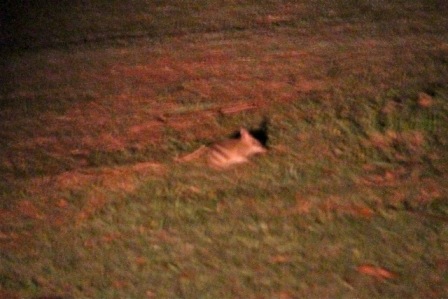
Eastern Barred Bandicoot, Port Sorell, Tasmania, 18/10/12 (Mike Unwin)
Bandicoots, by the way, are small, roughly rabbit-sized marsupials that specialise in digging. They are omnivorous, taking insects and their larvae, spiders, seeds, fruit and fungi, using their long snouts to smell them out. They have the shortest gestation periods of any mammal in the world – as little as 12.5 days, faster than that of a mouse.
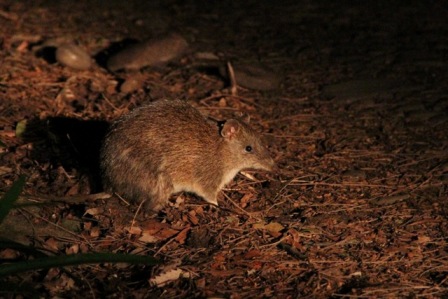
Southern Brown Bandicoot, Hawley Beach, Tasmania, 18/10/12 (Mike Unwin)
